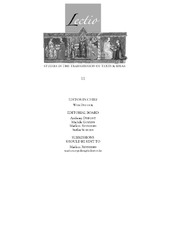Re-interpreting Tradition: Maximus the Confessor on Creation in Ambigua ad Ioannem
Поглавље у монографији (Објављена верзија)
Метаподаци
Приказ свих података о документуАпстракт
Maximus the Confessor’s Ambigua ad Ioannem represents a composition of 66 elucidations on ambiguous passages from the works of Gregory Nazianzen. The collection was written between 628 and 630 and dedicated to a certain John, whose identity is still under scholarly scrutiny. Although Ambigua, as a collection of various scholia, is mainly an exegetical work it may be to some extent subsumed under the popular Byzantine literary genre of erotapokriseis or question-and-answer literature, since the recipient of the work had selected different passages from Gregory and asked Maximus to ponder over their meaning. One of Maximus’ intentions in writing this work is the dismissal of Gregory’s alleged Origenistic or heterodox leaning (as in Ambiguum 7) and the justification of Gregory’s virtual infallibility and of his designation the ‘Theologian’ (as in Ambiguum 21). Moreover, Maximus displays his immense capacity to synthesize divergent theological traditions and to present them as parts of one... coherent theological system.
Извор:
Questioning the World. Greek Patristic and Byzantine Question and Answer Literature, 2021, 147-179Издавач:
- Turnhout: Brepols
Финансирање / пројекти:
- Министарство науке, технолошког развоја и иновација Републике Србије, институционално финансирање - 200025 (Универзитет у Београду, Институт за филозофију и друштвену теорију) (RS-MESTD-inst-2020-200025)
Колекције
Институција/група
IFDTTY - CHAP AU - Cvetkovic, Vladimir PY - 2021 UR - http://rifdt.instifdt.bg.ac.rs/123456789/2426 AB - Maximus the Confessor’s Ambigua ad Ioannem represents a composition of 66 elucidations on ambiguous passages from the works of Gregory Nazianzen. The collection was written between 628 and 630 and dedicated to a certain John, whose identity is still under scholarly scrutiny. Although Ambigua, as a collection of various scholia, is mainly an exegetical work it may be to some extent subsumed under the popular Byzantine literary genre of erotapokriseis or question-and-answer literature, since the recipient of the work had selected different passages from Gregory and asked Maximus to ponder over their meaning. One of Maximus’ intentions in writing this work is the dismissal of Gregory’s alleged Origenistic or heterodox leaning (as in Ambiguum 7) and the justification of Gregory’s virtual infallibility and of his designation the ‘Theologian’ (as in Ambiguum 21). Moreover, Maximus displays his immense capacity to synthesize divergent theological traditions and to present them as parts of one coherent theological system. PB - Turnhout: Brepols T2 - Questioning the World. Greek Patristic and Byzantine Question and Answer Literature T1 - Re-interpreting Tradition: Maximus the Confessor on Creation in Ambigua ad Ioannem SP - 147 EP - 179 DO - 10.1484/M.LECTIO-EB.5.121071 ER -
@inbook{
author = "Cvetkovic, Vladimir",
year = "2021",
abstract = "Maximus the Confessor’s Ambigua ad Ioannem represents a composition of 66 elucidations on ambiguous passages from the works of Gregory Nazianzen. The collection was written between 628 and 630 and dedicated to a certain John, whose identity is still under scholarly scrutiny. Although Ambigua, as a collection of various scholia, is mainly an exegetical work it may be to some extent subsumed under the popular Byzantine literary genre of erotapokriseis or question-and-answer literature, since the recipient of the work had selected different passages from Gregory and asked Maximus to ponder over their meaning. One of Maximus’ intentions in writing this work is the dismissal of Gregory’s alleged Origenistic or heterodox leaning (as in Ambiguum 7) and the justification of Gregory’s virtual infallibility and of his designation the ‘Theologian’ (as in Ambiguum 21). Moreover, Maximus displays his immense capacity to synthesize divergent theological traditions and to present them as parts of one coherent theological system.",
publisher = "Turnhout: Brepols",
journal = "Questioning the World. Greek Patristic and Byzantine Question and Answer Literature",
booktitle = "Re-interpreting Tradition: Maximus the Confessor on Creation in Ambigua ad Ioannem",
pages = "147-179",
doi = "10.1484/M.LECTIO-EB.5.121071"
}
Cvetkovic, V.. (2021). Re-interpreting Tradition: Maximus the Confessor on Creation in Ambigua ad Ioannem. in Questioning the World. Greek Patristic and Byzantine Question and Answer Literature Turnhout: Brepols., 147-179. https://doi.org/10.1484/M.LECTIO-EB.5.121071
Cvetkovic V. Re-interpreting Tradition: Maximus the Confessor on Creation in Ambigua ad Ioannem. in Questioning the World. Greek Patristic and Byzantine Question and Answer Literature. 2021;:147-179. doi:10.1484/M.LECTIO-EB.5.121071 .
Cvetkovic, Vladimir, "Re-interpreting Tradition: Maximus the Confessor on Creation in Ambigua ad Ioannem" in Questioning the World. Greek Patristic and Byzantine Question and Answer Literature (2021):147-179, https://doi.org/10.1484/M.LECTIO-EB.5.121071 . .



